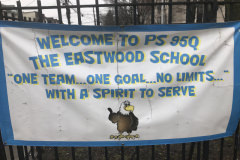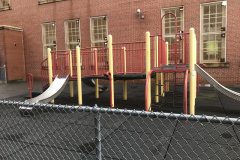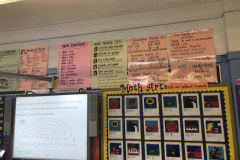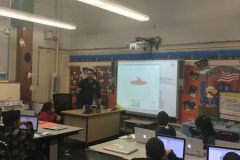As the State Legislature debates the budget for the upcoming year, AQE is joining Senator Robert Jackson — father of the Campaign for Fiscal Equity (CFE) lawsuit — for a statewide CFE Fact Finding Tour.
Senator Jackson and AQE will visit school districts across the state, with the aim of documenting the real-life educational consequences of New York State’s decades of underfunding of public schools and students. The team will tour schools to highlight what students need to succeed, as well as resources that are lacking. The team will be looking at impacts including the loss of teachers, guidance counselors, librarians, nurses and other staff; the lack of interventions and supports for at-risk students; the need for art, music, Advanced Placement and International Baccalaureate courses, electives, extracurricular activities, sports programs and after school programs.
Is your school district not on the tour? You can still participate from afar! We’re planning on visiting dozens of schools in cities, small cities and towns and rural districts across New York State to include in a report with our findings, but we know it’s not possible to visit every school.
If you want your district to be included in the final report, download our questionnaire to share with your local school district officials which they can fill out and return to AQE before February 20, 2019.
And don’t forget to follow the Fact Finding Tour in the coming weeks at the hashtag #EquityTourNY on your social media accounts!
Westbury High School | February 13
Westbury HS serves nearly 1,400 students in grades 9-12, over 80 percent of whom are economically disadvantaged. Overcrowding creates challenges for everyone at Westbury HS: for example, 30 students in a basement classroom that is too small and requires an escape ladder in case of emergency. The school makes use of all available space the best it can: the principal’s office is repurposed as a classroom for some periods, and the auditorium provides space for 2 classrooms.
When the bell rings, the hallways look like the LIE in rush hour, with 1,200 students in a school meant for 700. Teachers have to dive into the crowd and direct traffic and even turn whole groups around. This repeats 8 times a day.
Brentwood High School | February 13
New York State recommends 1 guidance counselor for every 100 students; Brentwood guidance counselors have 350 students.
P.S. 126 Dr Marjorie H Dunbar School | Bronx | February 13
M.S. 361 Highbridge Green School | Bronx | February 13
Food & Finance High School | Manhattan | February 13
Facing History High School | Manhattan | February 13
Peekskill High School | February 9
We visited Saturday Academy at Peekskill High School. Due to a lack of busing, some students walk miles in cold to get to school, or are forced to shell out $16 per day for cabs.
Grover Cleveland High School | Ridgewood, Queens | February 8
Grover Cleveland HS in Queens serves nearly 1,800 students. The Fact-Finding Team was shown around by Principal Marc Pascente, and had the opportunity to speak with students following the tour. Students take chemistry and the chemistry regents, but the school does not have a science lab to conduct experiments. Students complained about needing more counselors on staff at the school; when a student is in crisis or needs someone to talk to, the therapist and counselors are often overbooked. The current ratio of guidance counselors to students is 300:1.
Cornerstone Academy for Social Action Middle School (CASA) | Bronx | February 8, 2019
CASA Middle School in the Bronx serves 267 students in 6th-8th grade, over 80 percent of whom are economically disadvantaged.
Principal Jamaal Bowman and PTA President Ms. Walker took the team on a tour of CASA Middle School, showing how creativity has helped the school leadership make the best of the lacking resources — for example, Speech and Language classes are taught in a locker room. The school has decided to opt for computer programming instruction instead of foreign language, because the resources are not available to offer both.
P.S. 166Q Henry Gradstein Elementary School | Astoria, Queens | February 8, 2019
P.S. 166 serves 1,075 students in pre-K through 5th grade on the border of Astoria and Long Island City. We joined Principal Jessica Geller and Senator Mike Gianaris for a discussion with students. The students talked about safety concerns, and their concerns that due to large class sizes, they do not feel safe during lockdown drills because there is not enough space for all of them to hide. They said with more funding, they could hire more teachers and make the classes smaller.
Principal Geller said she would use the $800,000 that New York State owes P.S. 166 to hire more teachers, improve safety technology in their school, and hire a second music teacher so that every student could get a music class. Currently, music classes are only available to some grades but not others.
P.S. 8 Luis Belliard | Manhattan | February 8, 2019
P.S. 8 serves 554 students in grades pre-K through 5, with 96 percent of students living below the poverty level and over a third of whom are English Language Learners. Those students sit in classrooms with 32 children & 1 teacher.
Principal Washington Hernandez says the school prioritizes social and emotional wellness, but doesn’t have a social worker and has only have one guidance counselor for its 500 students due to a lack of resources. They’ve lost an academic intervention teacher and their social worker in recent years.
P.S. 95Q Eastwood | Jamaica, Queens | February 7, 2019
P.S. 95Q Eastwood serves 1,400 K-5 students. The school has one social worker for all students, who is available 2 days a week. For electives, students take music, art, and STEAM on a semester-by-semester rotation (two courses per semester).
The school building lacks any accessibility features such as elevators or ramps, and therefore cannot serve students with physical disabilities; during school events, they have to carry parents and grandparents up the front stairs so they can access the building to see their students. The school also makes use of mobile classrooms, which are not considered temporary but are not connected to the building.
C.S. 55 Benjamin Franklin | Bronx | February 7, 2019
C.S. 55 serves over 700 students from pre-K to 5th Grade.
The school does not have a library or librarian, the bathrooms need repair, and they lost a guidance counselor due to lack of funding. Next year, there will be one guidance counselor for 690 children.
I.S. 285 Meyer Levin School for the Performing Arts | Brooklyn | February 7, 2019
Pleasant Valley Elementary School | Schenectady | February 4, 2019
Pleasant Valley Elementary School in Schenectady serves almost 500 pre-K through 5th graders, 90 percent of whom are economically disadvantaged. The Fact Finding team was shown around the school by Principal Sean Inglee and accompanied by Superintendent Larry Spring.
School librarian Emily Roberts splits her time among 3 school buildings; as a result, students only have library and technology classes once every 2 weeks, and would need to have more dedicated class time to be able to do more in depth learning and research.
The school makes use of the space in the elevator lobby for student interventions and enrichment.
A sensory room supports students with social, emotional and trauma needs. Students may visit as often as 3 times per week. The district is only able to provide this type of support to about a third of the students who need it in the district. The room is staffed by a paraprofessional as a quiet space, but does not have therapists or social workers.
Schenectady City School District is owed $46,300,793, or $4,787 per pupil.






